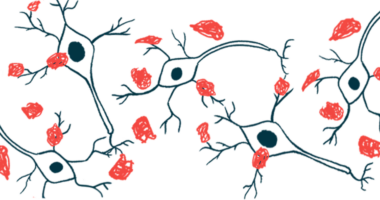Nerve Damage Seen in Skin Can Predict Parkinson’s Progression

In Parkinson’s patients, greater nerve damage in the skin around the ankle is significantly associated with subsequent progression of motor symptoms, while the presence of such damage in neck skin is linked to progressive cognitive decline, a study shows.
Notably, this nerve damage progression was not related to increased skin levels of damaging forms of alpha-synuclein, the protein that aggregates into toxic clumps in Parkinson’s.
Still, a combination of alpha-synuclein forms with nerve fiber damage in skin biopsies was able to accurately discriminate Parkinson’s patients from healthy people and those with other neurodegenerative disorders.
These findings support the use of a minimally invasive skin biopsy to assess diagnostic and prognostic biomarkers of Parkinson’s that have the potential to work as an indirect measure of neurodegeneration in the brain, the researchers noted.
The study, “Alpha-synuclein oligomers and small nerve fiber pathology in skin are potential biomarkers of Parkinson’s disease,” was published in the journal npj Parkinson’s Disease.
In Parkinson’s patients, nerve cell loss in the brain and spinal cord is triggered mainly by the toxic buildup of clumps of alpha-synuclein, a protein abundant in the brain and thought to help regulate nerve cell function and communication.
Small alpha-synuclein aggregates, called oligomers, have been shown to be the most harmful forms to nerve cells and to contribute to disease spreading in the brain.
Several tests of alpha-synuclein quantification and aggregation have been explored as potential diagnostic and prognostic biomarkers of Parkinson’s, with some studies showing that these toxic clumps can also be detected in skin biopsies, “opening the possibility to access [disease-associated] tissue in a minimally invasive way,” the researchers wrote.
Previous research also suggested that small nerve fiber damage evident in skin biopsies is associated with disease duration and progression in Parkinson’s patients. Small fibers in the skin relay sensory information about pain and temperature to the brain.
A research team at the Neurocenter of Southern Switzerland now evaluated the diagnostic and prognostic value of alpha-synuclein oligomers and declines in small nerve fiber number in skin biopsies of Parkinson’s patients followed for two years.
Oligomers were measured through a specific and sensitive tool called proximity ligation assay (PLA), and small fiber damage was assessed through intraepidermal [within the epidermis] nerve fiber density. The levels of phosphorylated alpha-synuclein, a toxic form thought to promote the formation of clumps, and aggregated alpha-synuclein were also analyzed.
Ankle and neck skin biopsies were collected from 30 Parkinson’s patients, 23 people with atypical parkinsonism, and 22 healthy individuals serving as controls.
Atypical parkinsonism comprises neurodegenerative diseases that cause symptoms similar to Parkinson’s. In this group, 12 people had multiple system atrophy (MSA) — which, like Parkinson’s, is caused by toxic alpha-synuclein clumps — and 11 had tauopathies, which are associated with the buildup of toxic aggregates of the tau protein.
Participants’ mean age ranged from 60 years in healthy people to 73.9 in those with tauopathies. People with atypical parkinsonism showed a more severe disease and greater cognitive impairment than Parkinson’s patients.
Results showed that people with Parkinson’s and MSA had significantly higher levels of alpha-synuclein oligomers in their skin biopsies than controls and people with tauopathies.
Compared with phosphorylated alpha-synuclein and protein aggregates, alpha-synuclein PLA showed the highest diagnostic accuracy among Parkinson’s, controls, and tauopathies. Particularly, the test correctly identified 80% of Parkinson’s cases and correctly ruled out 77% of healthy people and 82% of those with tauopathies.
Oligomer levels in the neck region also distinguished Parkinson’s patients from controls and people with tauopathies, while in the ankle region, only phosphorylated alpha-synuclein and protein aggregates allowed such a distinction.
By measuring early alpha-synuclein species in the aggregation pathway, “PLA can bear more sensitivity to early phases of disease than [phosphorylated alpha-synuclein],” the researchers wrote.
When looking at samples from the 24 Parkinson’s patients assessed at a two-year follow-up, the researchers found a significant reduction in the number of small nerve fibers in both neck and ankle skin biopsies after two years.
This drop was not accompanied by significant changes in alpha-synuclein markers or clinical measures.
Notably, fewer ankle skin nerve fibers at the first assessment significantly associated with a greater risk of motor impairment progression after two years, while a reduced number of neck nerve fibers was linked to a greater risk of cognitive decline. This was observed regardless of a patient’s age and levodopa equivalent daily doses.
These findings “are in line with brain pathology studies showing that clinical symptoms in PD [Parkinson’s disease] align with neuronal degeneration rather than with the [alpha-synuclein] aggregation burden,” the team wrote.
In addition, a skin biopsy-derived compound marker — based on all three harmful alpha-synuclein forms and the number of small nerve fibers — was able to differentiate with high accuracy (77.8%) patients according to their diagnosis.
These included the discrimination of Parkinson’s patients from those with MSA (84.6%), “which is a major challenge in clinical practice,” the researchers wrote. Particularly, this compound marker accurately identified 90% of Parkinson’s patients and correctly ruled out 66.6% of MSA patients.
These findings indicate that the choice of harmful alpha-synuclein marker “and the site of skin biopsy influences the diagnostic performance importantly and can help to understand the temporal dynamics of [alpha-synuclein] seeding and spreading in the peripheral nervous system during the course of the disease,” the researchers wrote.
Findings also support skin nerve damage as a potential marker of progression in Parkinson’s disease.
Larger studies are needed to confirm its prognostic value and clinical relevance, because if confirmed, skin nerve damage “could be considered as a proxy measure of neurodegenerative events occurring in the brain and possibly [a supplementary] biomarker in clinical trials,” they added.
“In conclusion, skin biopsy represents a minimally-invasive, easily-accessible, and repeatable source of biomarkers for PD,” the researchers wrote.







